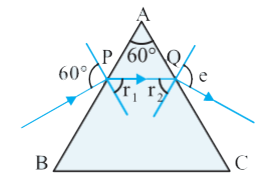The angle of a prism is 30∘. The rays incident at 60∘ on one refracting face suffer a deviation of 30∘. Then the angle of emergence is :
0∘
30∘
60∘
90∘
The correct Answer is:1
To solve the problem, we need to find the angle of emergence (E) from a prism given the angle of the prism (A), the angle of incidence (i), and the deviation (D).
1. Identify Given Values:
- Angle of the prism, A=30∘
- Angle of incidence, i=60∘
- Deviation, D=30∘
2. Understand the Relation of Angles:
- The deviation D is given by the formula:
D=i+e−A
- Here, e is the angle of emergence.
3. Substituting Known Values:
- Substitute the known values into the deviation formula:
30∘=60∘+e−30∘
4. Simplifying the Equation:
- Rearranging the equation gives:
30∘=60∘+e−30∘
- This simplifies to:
30∘=30∘+e
5. Isolating the Angle of Emergence:
- Subtract 30∘ from both sides:
0∘=e
6. Conclusion:
- Therefore, the angle of emergence e=0∘.
Final Answer:
The angle of emergence is 0∘.
---
- Angle of the prism, A=30∘
- Angle of incidence, i=60∘
- Deviation, D=30∘
- The deviation D is given by the formula:
D=i+e−A
- Here, e is the angle of emergence.
- Substitute the known values into the deviation formula:
30∘=60∘+e−30∘
- Rearranging the equation gives:
30∘=60∘+e−30∘
- This simplifies to:
30∘=30∘+e
- Subtract 30∘ from both sides:
0∘=e
- Therefore, the angle of emergence e=0∘.
The angle of emergence is 0∘.
Topper's Solved these Questions
- RAY OPTICS BOOK - VMC MODULES ENGLISHCHAPTER - RAY OPTICS EXERCISE - IN-CHAPTER EXERCISE-E
10 Videos
- RAY OPTICS BOOK - VMC MODULES ENGLISHCHAPTER - RAY OPTICS EXERCISE - IN-CHAPTER EXERCISE-F
10 Videos
- RAY OPTICS BOOK - VMC MODULES ENGLISHCHAPTER - RAY OPTICS EXERCISE - IN-CHAPTER EXERCISE-C
10 Videos
- QUIZBOOK - VMC MODULES ENGLISHCHAPTER - QUIZEXERCISE - PHYSICS
30 Videos
- RAY OPTICS AND WAVE OPTICS BOOK - VMC MODULES ENGLISHCHAPTER - RAY OPTICS AND WAVE OPTICS EXERCISE - IMPECCABLE
58 Videos
Similar Questions
The angle of a prism is 60∘ When light is incident at an angle of 60∘ on the prism, the angle of emerge is 40∘. The angle of incidence i for which the light ray will deviate the least is such that
View SolutionA ray passes through a prism of angle 60∘ in minimum deviation position and suffers a deviation of 30∘. What is the angle of incidence on the prism
View SolutionA ray of light is incident on one face of a prism (m=√3) at an angle of 60∘. The refracting angle of the prism is also 60∘. Find the angle of emergence .

View SolutionThe refracting angle of a glass prism is 30∘. A ray is incident onto one of the faces perpendicular to it. Find the angle δ between the incident ray and the ray that leaves the prism. The refractive index of glass is μ=1.5.
View SolutionThe refracting angle of a glass prism is 30∘. A ray is incident onto one of the faces perpendicular to it. Find the angle δ between the incident ray and the ray that leaves the prism. The refractive index of glass is μ=1.5.
View SolutionIf the refracting angle of a prism is 60∘ and the minimum deviation is 30∘, then the angle of incidence is
View SolutionThe angle of incidence for a ray of light at a refracting surface of a prism is 45∘. The angle of prism is 60∘. If the ray suffers minimum deviation through the prism, the angle of minimum deviation and refractive index of the material of the prism respectively, are :
View SolutionA ray of light is incident on one of the faces of the angle prism with an angle 40∘ with the surface. The angle of the prism is 60∘. The emergent ray is deviated through an angle 38∘. The angle of emergence is
View SolutionA light ray of yellow colour is incident on an equilateral glass prism at an angle of incidence equal to 48∘ and suffers minimum deviation by an angle of 36∘. (i) What will be the angle of emergence ?
(ii) If the angle of incidence is changed to (a) 30∘
(b) 60∘, state in each case whether the angle of deviatioin will be equal to, less than or more than 36∘. ?
View SolutionA ray of light is incident at an angle of 60∘ on one face of a prism of angle 30∘. The ray emerging out of the prism makes an angle of 30∘ with the incident ray. The emergent ray is
View Solution
